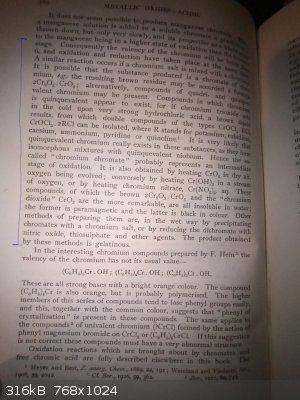| Pages:
1
2
3 |
Boffis
International Hazard
    
Posts: 1836
Registered: 1-5-2011
Member Is Offline
Mood: No Mood
|
|
I suspect that the strongly alkaline conditions caused by the use of excess KOH are causing atmospheric oxidation to Cr6+ and the colour is the sum of
the greenish Cr3+ hydroxide plus Cr6+ chromate. As the colour doesn't appear to be bleeding into the filter paper I suspect that the acual product is
some illdefined chromium 3+ hydroxide chromate. I seem to recal that there is an intermediate Cr3+/Cr6+ oxide.
|
|
|
teodor
National Hazard
   
Posts: 872
Registered: 28-6-2019
Location: Heerenveen
Member Is Offline
|
|
Hm...
I tried to check whether is there any Cr(VI).
I smeared the compound over 8 inch watch glass and gave enough time for oxidation. Then I redissolved it in HCl and got very dark green solution. I
filtered it and added some Pb(NO3)2 solution. It gave pure white precipitate (PbCl2) and a green compound as a solution. It was always pure white
precipitate and green solution not depending how much Pb(NO3)2 I was adding.
So, I neutralised it then with KOH and got the same olive brown precipitation.
So, I failed to isolate any Cr(VI) out of this.
[Edited on 7-11-2020 by teodor]
[Edited on 7-11-2020 by teodor]
|
|
|
Boffis
International Hazard
    
Posts: 1836
Registered: 1-5-2011
Member Is Offline
Mood: No Mood
|
|
Did you test it with a redox indicator such as benzidine or tetrabase? Did you try testing with diphenylcarbazide? If not your tests are so crude as
to be meaningless. The reason lead compounds were used in the past to make white pigments was precisely their ability to mask other colourant. The
amount of Cr6+ you are looking for would probably not create a coloured ppt. That's assuming that the chromium3+ hydroxide-chromate is soluble in
dilute HCl anyway.
Have your bothered to read up on hydrated chromium oxides under highly alkaline conditions? Try starting with the SM library.
|
|
|
teodor
National Hazard
   
Posts: 872
Registered: 28-6-2019
Location: Heerenveen
Member Is Offline
|
|
Thanks, Boffis. Indead, my test was very rude and I did it fast. In the case of its failure there can be many reasons but success would definitely
show Cr(VI) presence what I hoped to get. I assumed that PbCrO4 as a less soluble salt should precipitate before PbCl2 but it was just a guess not
based on any study of the theory.
I didn't know about masking properties of white lead salts.
Sure, I will read more on the topic.
I just listed a book few minutes ago and found this compound mentioned (Fritz Ephraim) as well as different methods to obtain it:

|
|
|
| Pages:
1
2
3 |